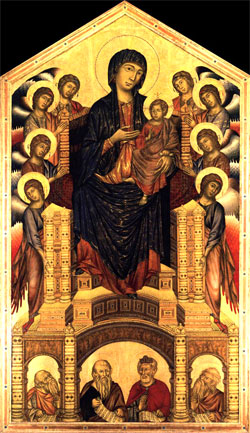Cimabue c. 1240 - c. 1302
Cimabue determined the particular course of art development in Florence at the end of the Medieval period.
What the Roman and Sienese art lacked, a radical appeal to nature, found its conscious expression in the arts promoted in Florence under the influence of the Franciscan revival. Dante established Italian as a literary language, ending the dominance of Latin, and, with Cimabue and Giotto, it was now the art’s turn to speak in vernacular.
Up to the latter half of the 13th century, the paintings belonging to the Florence school were no superior to works created in other important Italian cities. Generally, all of them were showing inferior craftsmanship when compared to the classical Roman art, lacking its basis of large and gracious feeling.

Cimabue
Madonna Enthroned with Angels and Prophets
1285-86
Galleria degli Uffizi, Florence
Suddenly, a new and personal force appeared in Tuscany. This expressed itself at Assisi in a series of remarkable frescoes in the newly completed Church of St. Francis. These works have been traditionally attributed, since the early 16th century at least, to Cimabue, whose personality is surrounded by many legends and fewer documented records.
The established facts regarding Cimabue are presenting evidence that he worked in Rome in 1272 and in Pisa in 1301. According to tradition, sometime between 1272 and before 1300, he was painting in Assisi. There is the contemporary evidence by Dante, stating that Cimabue was a leader in painting, and, without doubt, he influenced Giotto, who was reaching maturity at the time of Cimabue's death in 1302.
Among the Medieval painters, Cimabue stands high due to the character and the fresh spirit of his paintings. As he departed from the Byzantine formula, Cimabue accepted the Tuscan conventions and asserted his provincial and Italian artistic spirit. He is still archaic, with a conventional drawing, his figures have the heads too large, and the groups are huddled. But his paintings and frescoes are showing the deep passion and the intuition of nature, a vivid energy, working like fire through the old, Byzantine-inspired formulas. He does not have the refinement of Duccio, is often stern and homely. But his works are full of deep passion, and have a direct intuition of nature.
The clearest idea of the master's power can be gathered only in the Church of St. Francis at Assisi. The construction began in 1228, two years after St. Francis' death. The Lower Basilica was rapidly finished in 1230. The entire construction was completed in 1253. The monumental series of frescoes attributed to Cimabue can be found in the apse and transepts of the Upper Basilica, with its cross-vaulting. They far surpass in conception and form any earlier works of the kind in Europe.
The Crucifixion fresco
The large fresco of the Crucifixion on the wall of the South transept shows the artist's genius. Incomplete as it is, we feel the thought, a personal expression of inexhaustible sublimity. Its conception it is passionately loyal to the Franciscan ideal of mystical devotion, while in form it shows a direct appeal to life. Stretching out on each side of the Figure on the Cross, the surrounding crowds are massed in two groups. The centurion and spectators are on the right, the disciples on the left. There is a sense of releasing movement, of a central event in time and in space.
The details are amazing: there is the figure of St. Francis throwing himself down at the foot of the Cross, the firmly planted soldier on the right grasping his shield, the nobly conceived figure of the centurion, the gesture of the Magdalen, and the stormy flight of angels. The fact that is ruined, and archaic, does not destroy the picture's supreme spiritual power.
Madonna Enthroned and other paintings
The other frescoes of the series, including the Crucifixion of St. Peter, which Giotto copied, contain thrilling passages. The “Madonna Enthroned with Angels and St. Francis”, another fresco in the Lower Basilica attributed to Cimabue and dating from 1280, shows delicacy and finish united to robust forms, with the ascetic St. Francis remarkable in character.
Cimabue's Madonna panel paintings are more medieval in form than the frescoes, and are less fine and bold in execution. However, the tendency toward naturalism can still be identified.
Cimabue’s art stands on its own, not only as belonging to the master of the future revolutionary genius Giotto. In his own right, Cimabue must be hailed as a pioneer of the Renaissance art, and in a certain passionate and personal conviction, he surpasses even Giotto.
